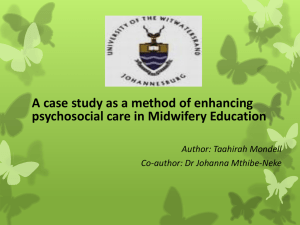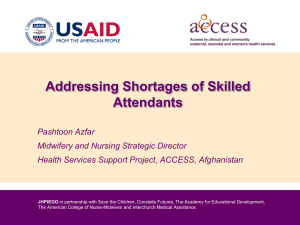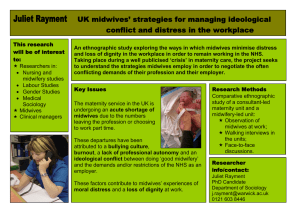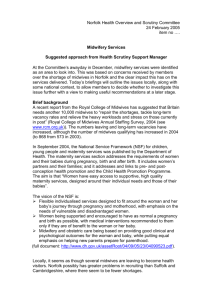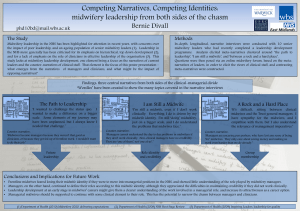A Glance at the Tradition of Midwifery
advertisement
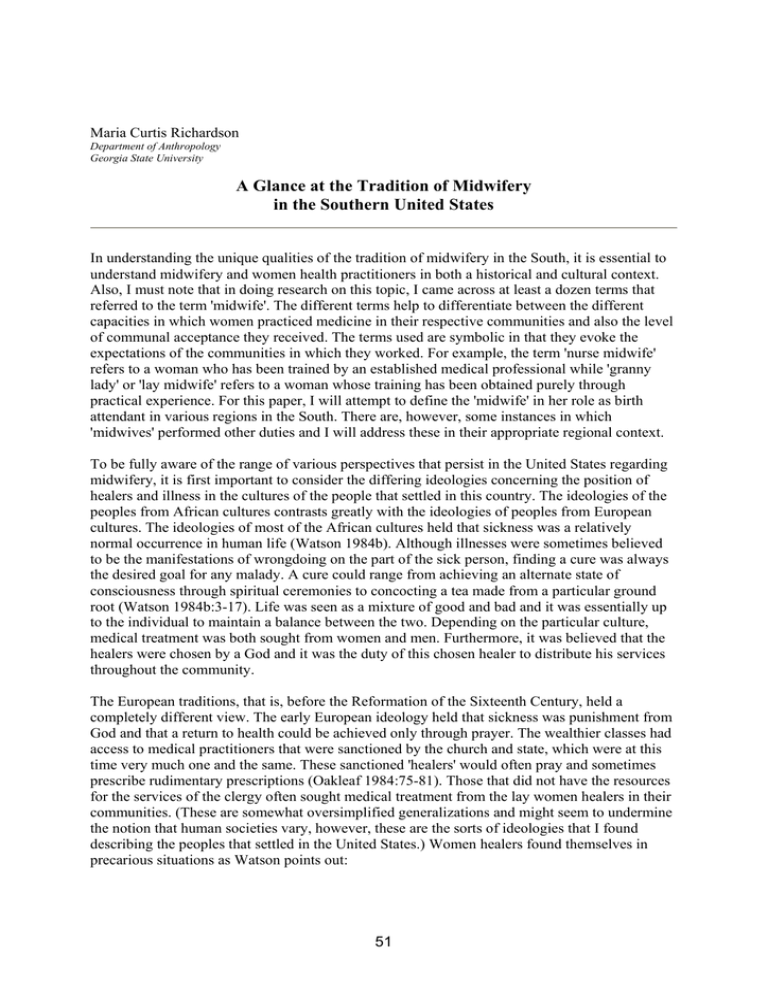
Maria Curtis Richardson Department of Anthropology Georgia State University A Glance at the Tradition of Midwifery in the Southern United States In understanding the unique qualities of the tradition of midwifery in the South, it is essential to understand midwifery and women health practitioners in both a historical and cultural context. Also, I must note that in doing research on this topic, I came across at least a dozen terms that referred to the term 'midwife'. The different terms help to differentiate between the different capacities in which women practiced medicine in their respective communities and also the level of communal acceptance they received. The terms used are symbolic in that they evoke the expectations of the communities in which they worked. For example, the term 'nurse midwife' refers to a woman who has been trained by an established medical professional while 'granny lady' or 'lay midwife' refers to a woman whose training has been obtained purely through practical experience. For this paper, I will attempt to define the 'midwife' in her role as birth attendant in various regions in the South. There are, however, some instances in which 'midwives' performed other duties and I will address these in their appropriate regional context. To be fully aware of the range of various perspectives that persist in the United States regarding midwifery, it is first important to consider the differing ideologies concerning the position of healers and illness in the cultures of the people that settled in this country. The ideologies of the peoples from African cultures contrasts greatly with the ideologies of peoples from European cultures. The ideologies of most of the African cultures held that sickness was a relatively normal occurrence in human life (Watson 1984b). Although illnesses were sometimes believed to be the manifestations of wrongdoing on the part of the sick person, finding a cure was always the desired goal for any malady. A cure could range from achieving an alternate state of consciousness through spiritual ceremonies to concocting a tea made from a particular ground root (Watson 1984b:3-17). Life was seen as a mixture of good and bad and it was essentially up to the individual to maintain a balance between the two. Depending on the particular culture, medical treatment was both sought from women and men. Furthermore, it was believed that the healers were chosen by a God and it was the duty of this chosen healer to distribute his services throughout the community. The European traditions, that is, before the Reformation of the Sixteenth Century, held a completely different view. The early European ideology held that sickness was punishment from God and that a return to health could be achieved only through prayer. The wealthier classes had access to medical practitioners that were sanctioned by the church and state, which were at this time very much one and the same. These sanctioned 'healers' would often pray and sometimes prescribe rudimentary prescriptions (Oakleaf 1984:75-81). Those that did not have the resources for the services of the clergy often sought medical treatment from the lay women healers in their communities. (These are somewhat oversimplified generalizations and might seem to undermine the notion that human societies vary, however, these are the sorts of ideologies that I found describing the peoples that settled in the United States.) Women healers found themselves in precarious situations as Watson points out: 51 "...the very act of healing and the belief in demonic possession proved a woman a witch; but if she took as her defense that she really had not healed anyone, then she was a counterfeit witch and worthy of death for deceiving people. The difference between being a witch and a physician was as clear as the difference between being a woman and a man, between being a peasant and a non-peasant, "uneducated" and "educated". The physician, said the church and the state, came from God, the witch came from the devil. The establishment feared that the white witch was narrowing the gap between ruler and ruled in theological, economic, political, and sexual terms" (1984a:80-85). What is particularly interesting about the American-held views of midwifery is the way in which the varying ideologies played themselves out. At the outset of my research I imagined that in the Northeastern most states, midwifery was generally not tolerated, a testimony to this being the Winston-Salem witch trials. I was wrong, however. The correlation between acceptance and nonacceptance of midwifery seems to lie in the ruralness of the region in question. The further away from a prominent 'establishment', the more likely midwifery was to persist. There exist some rural regions in the North where midwifery of the nineteenth century resembled midwifery in the South, as was documented in studies done in rural Newfoundland and Labrador (Benoit 1989). During the Colonial days in our country's history, it was accepted that it was a woman's job to assist in the birth of children. In fact, in Maine in 1646, a man was actually persecuted for "acting as a midwife" (Litoff 1978:4). The colonial midwife and a couple of the parturient woman's female kin were the only people admitted to the 'laying-in room'. It was not, at this time, deemed appropriate that the parturient woman's husband be admitted. The entire birth process was viewed as an event that should be left entirely to the handling of women. It is my guess that colonial midwives were allowed this power for several reasons. First, because the people in the colonies were fundamentally different than their European contemporaries in that they were either religious dissenters or from the lower classes that did not particularly adhere to the laws of the church and state in the first place. Secondly, the lack of a formidable, dominating, religious establishment led to more individual freedom, and thirdly because the first townships were 'rural' in that they lay far from one another and were, at this time, underdeveloped. The single most important event that proceeded to alter the practice of midwifery was the invention of the obstetric forceps by the British surgeon, Peter Chamberlain, The Elder in the early seventeenth century (Litoff 1978:7). Midwives could not purchase the forceps as they were only sold to physicians. A series of other events in this field continued to displace the colonial midwife. Women were not admitted to the prestigious medical schools and in fact many "doctors were convinced that the uterus and the central nervous system were closely connected...(and that) shocks to the nervous system, such as prolonged or intense study might, in turn, prohibit a woman's reproductive organs from growing to full maturity...physicians argued that those women who dared to engage in serious intellectual pursuits, such as the study of medicine, faced the grave risk of being unable to produce normal, healthy children" (Litoff 1978:13). Eventually, the midwife's capabilities began to be viewed as inferior to those of the male physicians. By 1860, urban, middle and upper class Americans had begun to seek the services of male physicians because they began to embrace the idea that "childbirth was a disease that could most properly be controlled by the use of instruments, drugs and surgery "(Litoff 52 1978:14,21). Men who were believed to be skilled in the use of instruments were summoned to aid in childbirth all the way back to the time of Hippocrates (Suiter 1981:280). It is interesting in this regard to notice that men were associated with tools and the knowledge to manipulate tools. It is precisely from this rationalization of the middle and upper classes that the questioning of the role of the midwife became a class-biased issue. It should be noted that in not all areas of the South did midwifery continue to persist. In fact, significant advances in the field of obstetrics were made in parts of the "Deep South', for example in 1809 a Kentucky physician named Emphraim McDowell performed the first successful ovariotomy (Litoff 1978:18). J. Marion Sims, often called the father of modern gynecology, was educated at the Medial College of South Carolina and also in Philadelphia, then moved to Alabama where he began practicing medicine. Through experimentation on slave women, he was able to develop a cure for the vesica-vaginal fistula in 1849 (Litoff 1978:18). Dr. Robert Battey of Rome, Georgia was credited with the invention of the "normal ovariotomy" in 1872 because he suggested that "the removal of the ovaries (be done) for non-ovarian causes, such as neurosis, insanity, abnormal menstruation, and practically anything untoward female behavior" (Litoff 1978:18). Although seven of the ten states that currently have legislation enabling midwifery are in the south and southwest, Alabama and Kentucky are not among them (Butter and Bonnie 1988:1162-1163). The information that I have gathered on the regions in the South where midwifery has persisted, have shown that they were all relatively isolated, either racially or geographically, from the trend toward physicianstyle births. Although all of the different regions where midwifery survived past 1860 are characteristically different in many ways, there exist some shared aspects. Until the passage of the SheppardTownsend Maternity and Infancy Act of 1921, no public funds had been set aside for the training of midwives (Litoff 1978:99). It was around this time that the southern states began addressing "the midwife problem', they realized that midwives were a "necessary evil" because of the fact that it was nearly impossible to expect doctors to travel great distances to deliver all babies in rural areas (Litoff 1978:54,100). Dr. O.R. Thomas insisted that the southern midwives were more difficult to train because they were primarily "ignorant and superstitious Negroes" (Litoff 1978:78). Unfortunately, the funding instituted by the Sheppard-Townsend Act was withdrawn with the onset of the Great Depression. One very important finding was that most of the practicing midwives originally had no intention of ever becoming midwives (e.g., Litoff 1978:5; Susie 1988:12; Benoit 1989:635; Oakleaf 1984:80; Schaffer 1991:94). The process by which women became midwives was much like that mentioned in Valerie Fennell's article which describes women's social networks in the South in which she states that traditions are generally passed on by "(1) a friend close in age, (2) a kinswoman, often of a different generation, or (3) a friend not so close in age, but one introduced...by a peer-link” (1981:139). Often, midwives in the South were not paid for their services in money, sometimes they were paid in foodstuffs during harvests and sometimes they were not paid at all. It was an unwritten law of the community that midwives were not to ever turn down a patient, no matter who the client. Also, all sources confirmed that midwives stayed on the average nine to ten days with the women's whose childbirths they had assisted in. During this period, the midwives instructed the mothers on how to take care of their newborns, kept house for the recovering mothers (i.e., cooked, cleaned, took care of the family's other children, 53 tended gardens, etc.) and stayed with the new mothers until they were visibly able to carry on their normal household duties. In addition to this, midwives carried their own sterilized linens and diapers in anticipation that their clients might not have these items. Now I will begin describing some of the various regions where midwifery endured. I will start with the African American midwives in Florida. Midwives were held in very high regard in the communities in which they served. There were essentially two ways in which a woman became a midwife; one was either the kin of a midwife or one was "asked by God" (Susie 1988:10). Many of the midwives in Florida reportedly became midwives as a result of their older kinswomen not being home, in which case they relied on the information that had been passed along to them in the form of stories and on their limited experience in assisting in childbirth (Susie 1988:10-11). They employed massaging and herbal teas at critical moments to help keep the parturient women's pain to a minimum. As was stated earlier, financial security was never available. The virtual never-ending flow of foodstuffs and animals for services rendered helped ensure the midwives security. Also, midwives were held in such high regard with their clients, particularly those whom they had serviced more than once, that they were always assured subsistence from the community. Most times when a women's customary midwife had died, they chose to have their children in the hospital rather than to utilize the services of another midwife. The women of this region were only involved in the birth of children, unlike some other Southern midwives who also tended the sick. The midwives in this particular region were, by and large, very religious. It is for this reason that they insisted that they did not perform abortions (Susie 1988:30). From the way that the information was presented on this region, I got the impression that the women did have the knowledge of how to perform abortions but did not because of their religious convictions. The midwives in Florida maintained a somewhat unusual disbelief of the scriptures in the Bible that stated that childbirth was "Eve's punishment and curse of guilt and pain" (Susie 1988:22). The women felt that childbirth was a gift from God and would even go so far as to take in the unwanted children whom they delivered rather than perform abortions. Many of the midwives in this area expressed a desire to aid in the delivery of multiple births. One 'granny', as they are typically called throughout the South, confessed that after having delivered triplets she "could not sleep for joy" (Susie 1988:27). The traditional lay midwifery in the region, as in all other regions of the United States, was revised by physician-style birth practices. Women began to be trained by State medical officials, instead of by the traditional apprenticeship methods which had existed earlier. Florida's midwives represent three distinct cultures: the African American, Native American, and the Latin communities (Susie 1988:viii). The tradition of midwifery in the Ozarks differs greatly from that in Florida. The people of the Ozark mountain region are primarily of British heritage, English and Scottish to be more exact. This area was so isolated that one researcher in 1964 "found people who spoke of the "old" and "new" Christmas which was changed by the King of England in the eighteenth century and who never knew that there had been a civil war although (some) had been alive during the 1860's" (Oakleaf 1984:71). This isolation from other groups had preserved the notions of witchcraft that prevailed in Britain in the seventeenth century (Oakleaf 1984:71). 54 The idea of "good" or "white" witches and "bad" or "black" witches existed much the same as it did in Britain. The belief that illicit sexual encounters qualified a woman for being a witch was present in Ozark thought just as it was in Britain," it is believed that a virgin cannot be a witch...moreover, it is thought that a woman often learns the secret of witchcraft from a man with whom she has had sexual intercourse" (Oakleaf 1984:74). The "white witch" in the Ozarks was said to perform a variety of services for the community: "Often a midwife as well as a healer, the white witch as the person who doctored the village people and their animals, and also delivered the offspring of both" (Oakleaf 1984:74). The main difference between the Ozark people and their eighteenth century British counterparts was the absence of a ruling class. This absence allowed for more personal autonomy on the part of the midwives of this region. A more recent study has been done on the African American midwives in the Texas Brazos Bottom. As late as the nineteen- eighties, this group was still involved a great deal in delivering children in their communities. The study showed that they functioned more in the capacity of nurse-midwife in that they were, for the most part trained by physicians. This stage of midwifery has evolved, no doubt, as a result of the presence of a medical establishment. The existence of older forms of midwifery traditions was present in the rituals involved in childbirth which will be mentioned later. The nurse midwives were often picked by physicians based on personality traits that were deemed compatible with those of a good midwife. Many times their mothers and grandmothers had been midwives. As a group, they did not provide postnatal care as was typical with other midwives, Schaffer did not mention whether or not this was a recent phenomenon or whether it was something that was not an original component in this regions's traditions 1991:95). The midwives of this region stressed the importance of performing numerous services since the services did have set monetary prices. These women practiced a higher level of professionalization than did other groups in the South, perhaps this is a result of modernization making living by bartering virtually impossible. These women, especially the older ones, practiced ritualistic burials of the placentas of the newborns they delivered. In certain regions of Africa, the appropriate disposal of the placenta is regarded as very important because it is believed that the body and placenta are joined again at death (Schaffer 1991:95). The standard procedure for the burial of the placenta is to sprinkle it with salt, which preserves it, then to wrap it in a white cloth, then to bury it (Schaffer 1991:95). The midwives in this region did at the time of the study provide clean linens and instruct the patient on what to eat. Their prescribed diet was one that was non-greasy and low in salt. Also, some clays in the region are believed to have nutritional value and was often prescribed as a supplement to the regular diet. None of the women admitted to performing abortions, however, they were all aware of three methods which can onset abortion (1) massage, (2) herbal teas, and (3) the "doctor method" (Scaffer 1991:97). Notice that the African American women in Florida also had a shared knowledge of massage and teas which soothed the parturient woman. The women were supposedly capable of earning much money performing abortions. The desegregation in the region has incredibly weakened the midwife in the Texas Brazos Bottom. Apparently, many of the midwives’ would-be clients are 55 going to medical clinics because the cultural conception is that it is the 'better' way. Schaffer summarizes the current situation by saying: "While improved health care aided the health of black youth and women and improved labor force productivity, it also improved the quality of life for a subordinate population that would not have been otherwise possible. This improvement while modest, has some merit when juxtaposed against the current lack of medical services in poverty neighborhoods of rural areas and big cities, where low-weight babies and high infant mortality have become endemic problems" (Schaffer 1991:102). Another group of European American midwives that were quite successful were those that lived in Rabun County, Georgia. Birth attendants in this region are referred to as either "granny" or "midwife" (Cox 1973:274-303). "Granny" referred to the traditional lay midwives that practiced before the opening of the Rabun County Health Office in November of 1942. The birth attendants that worked at the Health Office, which was a maternity ward, were trained according to the standards of nurse-midwifery. The ward was enormously successful and drew patients from all over Georgia, Tennessee and Alabama. The granny women functioned much in the same way as did the midwives in Florida except that they traveled further distances as their neighbors lived further apart in the rocky terrain of the North Georgia mountains. There was no set price for services by either the granny women or the midwives. Payment was often in foodstuffs and in material items other than money. The question of performing abortion was never mentioned. The midwives and granny women of this region had enormous pride in accomplishing the goal of an established maternity ward. There was a deep sadness expressed by these women that most couples were choosing to go to hospitals instead of employing the services of a midwife. The sources referred to did not explain why the change to hospital births had occurred. The establishing of the maternity ward was an accomplishment of the community and of the local midwives, but was also a step in the direction of modernization in the field of obstetrics. The Rabun County Health Office is now the office for the Highway Department (Cox 1973:280). I have attempted to describe some of the midwifery groups of the South in terms of their historical, cultural, ideological and geographical contexts. It is important to note that while midwifery perpetuated itself in the South because of economic, racial and geographical isolation, midwifery in the North persisted among the immigrant groups in much the same way. The dominant cultural groups insisted on lumping immigrants, African Americans and people of the European American lower classes within a framework that they suggested was "backward" and "ignorant". Debra Anne Susie notes that "...the racial and ethnic makeup of the woman of the lower economical and educational ranks was played upon by the "white" population's prejudices, remaking the midwife into some kind of un-American apparition and casting a suspicious shadow over her character as well as her work. A well-circulated ad depicted three midwives; an Italian woman, a Southern Black woman, and an Irish woman, each dressed in dark, old-world garb and framed against an even darker background- a clear contrast to the slim, fashionable women in the adjoining ads" (Susie 1988:5). The question of admitting men into the laying-in room was a much debated one in earlier years. While it was true that men were summoned in times of emergencies, the practice of admitting men into the laying-in room did not occur in United States until after the development of the 56 forceps. Many men felt that it was improper to be present while a woman was giving birth. Other men believed that to be with one's wife while she was giving birth was the only thing a 'good' husband could do: "If he be a prudent man, of good moral force, competent to comfort, encourage and aid in sustaining his wife through the conflict of parturition,...the parties (husband and wife) mutually assist each other, at this as well as other times of matrimonial life" (Suitor 1981:284, quoted Warrington 1854:171). J. Jill Suitor suggests that it is the admittance of male physicians that ultimately made it acceptable for husbands to be present for the births of their children (1981). Suiter also makes reference to physicians that were adherents to "The Botanical Order", a sect of practitioners that was founded in the 1820's (1981:283-84). The Botanical Order was founded by a farmer named Samuel Thomson who practiced healing which he learned from a "root and herb" doctor (1981:283). Thomson is said to have emphasized self-help and he spoke out against many of the treatments that were commonly prescribed by nineteenth-century physicians such as the use of leaches and bloodletting (Suitor 1981:273). Thomson, as well as many of his followers, favored the use of midwives rather than physicians for normal births ("normal birth" refers to one without medical complications such as prematurity, an obvious disproportion between the mother's pelvis and the infant's head, an unusual presentation of the fetus, or any situation that would necessitate the use of instruments, Suiter 1978:280). Suitor states "Thomson's social class facilitated his popularity with members of the working classes in the South and Midwest" and that some of the principles of The Botanical Order continued being practiced throughout the nineteenth century (1981:273). It is uncertain whether or not black husbands attended the births of their children. Suitor quotes Engelmann (1880) as saying that "sometimes "Negro" women's husbands participated in births in rural areas of Georgia and Virginia" (1981:1972, quoted Litoff 1978 and Wertz and Wertz 1977). Other authors that Suitor referred to imply that "black women were opposed to the presence of men" (1981:272). In all sources that I referred to, the only mention of men's participation was that which occurred outside the laying-in room. Midwives told of men summoning them when their wives had started going into labor and that men generally did what they could to help. Most often it was the men that delivered foodstuffs to the midwives in return for their services. Fathers also helped maintain ties to the midwives after the births of their children by doing such things as chopping wood and general household repairs (Cox 1973 and Susie 1988). One would imagine that through such networks that midwives always maintained a contact with the families that they serviced and therefore watched the children they had helped to bring into the world grow up. Typically, a child who had been delivered by a midwife felt very strongly for her throughout their life and would often employ the same midwife in the birth of their own children (Cox 1973 and Susie 1978). The midwives in the South did much more than function as birth attendants. Midwives in the South acted as nurse, care giver, nanny, counselor, housekeeper, transmitter of information, folk doctor and many other things. Midwifery persisted as it did in the South, and other regions, due to ruralness or isolation from the trend toward physician-assisted 57 births. By studying the roles of midwives we can better understand the extent to which human beings relied on both personal and communal knowledge before the widespread use of physicians and hospitals. References Cited Benoit, Cecelia 1989 Traditional Midwifery Practice: The Limits of Occupational Autonomy. The Canadian Review of Sociology and Anthropology, Vol. 26: 634-649. Bonnie, J. Kay Ph.D., and Irene H. Butler. 1988 State Laws and the Practice of Midwifery. The American Journal of Public Health, Vol. 78, 9: 1161-1169. Campbell, Marie. 1946 Folks Do Get Born. New York and Toronto: Rhinehart and Company. Cox, Karen 1973 Midwives and Granny Women. In Foxfire 2. Eliot Wigginton, ed. Pp. 274-303. New York: Anchor Books, Anchor Press and Double Day. Davis, Allison, Burleigh B. Gardner, and Maty R. Gardner 1941 Deep South. Chicago: The University of Chicago Press. Engelmann, George 1880 Posture in Labor In A Treatise on the Science and Practice of Midwifery. Lancet. W.S. Playfair, ed. Philadelphia: H.C. Lea. Suiter, J. Jill. 1981 Husbands' Participation in Childbirth: Nineteenth-Century Phenomenon. Journal of Family History. Pp. 278-293. Funnell, Valerie 1981 Friendship and Kinship in Older Women's Organizations: Curlew Point, 1073. In Dimensions: Aging, Culture and Health. Pp. 131-143. Brooklyn, New York: J.F. Bergin Publishers, Inc. Litoff, Judy Barrett 1978 American Midwives: 1860 to Present. Westport, Connecticut and London, England: Greenwood Press. McElroy, Ann and Patricia K. Townsend 1985 Medical Anthropology in Ecological Perspective. Boulder, San Francisco and London, England: West View Press. McGhee, Nelson Jr. 1984 Afterwork In Black Folk Medicine: The Therapeutic Significance of Faith and Trust. Wilbur H. Watson, ed. Pp. 99-101. New Brunswick, New Jersey and London, England: Transaction Books. Oakleaf, Zoe D. 1984 Ozark Mountain and European White Witches. In Black Folk Medicine: The Therapeutic Significance of Faith and Trust. Wilbur H. Watson, ed. Pp. 71-87. New Brunswick, New Jersey and London, England: Transaction Books. Schaffer, Ruth C. 1991 The Health and Social Functions of Black Midwives on the Texas Brazos Bottom, 1920-1985. Rural Sociology 56 (1): 89-105. Susie, Debra Anne. 1988 The Community's View of the Midwife. In the Way of Our Grandmothers: A Cultural View of Twentieth-Century Midwifery In Florida. Pp. 9-34. Athens, Georgia and London, England: The University of Georgia Press. In Suiter, J. Jill. 1981 Husbands' Participation In Childbirth: A Nineteenth-Century Phenomenon. Journal of Family History. Pp. 278-293. Warrington, Joseph. 58 1854 Obstetrical Catechism. Philadelphia: Lipincott, Grambo. In Suiter, J. Jill. 1981 Husbands' Participation In Childbirth: A Nineteenth-Century Phenomenon. Journal of Family History. Pp. 278-293. Watson, Wilbur H., ed. 1984a Folk Medicine and Older Blacks In the Southern United St a t e s . In Bl a c k Fo l k Medicine: The Therapeutic Significance of Faith and Trust. Wilbur H. Watson, ed. Pp. 53-67. New Brunswick, New Jersey and London, England: Transaction Books. 1984b Introduction. In Black Folk Medicine: The Therapeutic Significance of Faith and Trust. Wilbur H. Watson, ed. Pp. 1-17. New Brunswick, New Jersey and London, England: Transaction Books. Wertz, Dorothy C. and Richard W. Wertz 1977 Lying-In: A History of Childbirth In America. New York: Schocken Books. 59
